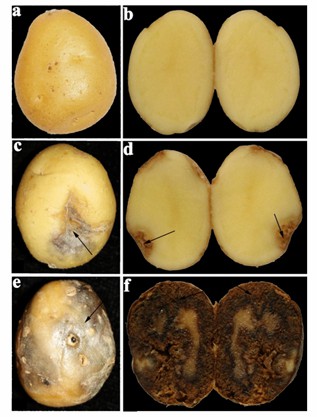Rotten stem nematode, also known as sweet potato stem nematode, is the most common occurrence in potato planting. The disease has the characteristics of the epidemic, sudden, hidden, and so on, and is sensitive to environmental temperature. It will cause serious harm to potato’s normal growth, manifested in the loss of nutrients, the overall decline of disease resistance, and the induction of a variety of compound diseases. Therefore, the planting yield decreases significantly, and the economic value shrinks.
Lifeasible is committed to helping our customers achieve effective and successful research. We provide conveniently and guaranteed analysis of potato stem rot nematode diseases. In addition, we deliver reliable results and reports on time to our customers worldwide.
 Fig.1 External and internal symptoms in potato tuber caused by Ditylenchus destructor. (Li Y et al., 2022)
Fig.1 External and internal symptoms in potato tuber caused by Ditylenchus destructor. (Li Y et al., 2022)
We provide cloning and functional analysis of potato stem rot nematode related genes using RACE techniques, bioinformatics, fluorescent quantitative PCR, and dsRNA immersion in vitro to induce target gene silencing in plant nematodes to help our customers analyze pathogenic mechanisms.
Lifeasible has extensive experience and expertise in plant science. We are committed to providing you with timely and high-quality deliverables. At the same time, we guarantee the cost-effectiveness, completeness, and simplicity of the report. If you are interested in our services or have any questions, please feel free to contact us or make an online inquiry.
Reference
Lifeasible has established a one-stop service platform for plants. In addition to obtaining customized solutions for plant genetic engineering, customers can also conduct follow-up analysis and research on plants through our analysis platform. The analytical services we provide include but are not limited to the following:
July 13, 2024